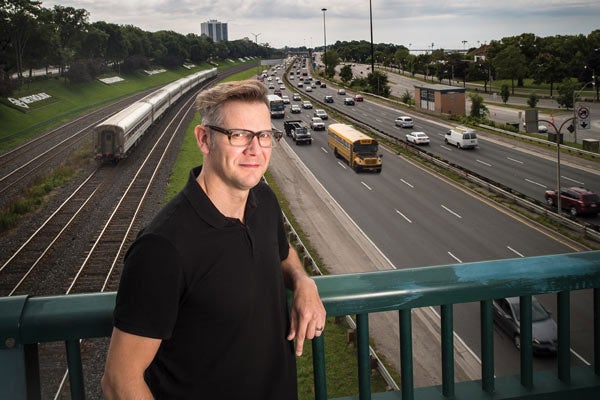
Kid-friendly cities: the importance of walking to school
Published: November 25, 2013
Do you let your kids walk by themselves to school? If not, Ron Buliung of the Department of Geography at the University of Toronto Mississauga wants to know why.
Buliung is a transport geographer who examines the relationship between children and cities, with a particular focus on how kids get around.
“I’m interested in children, mobility, activity and health,” he says, noting that some of the decisions adults make about children’s lives relate to the politics, design and structure of cities — from political decisions about user fees for city-run programs to the layout of our roads and decisions regarding speed limits — and are informed by their beliefs about whether children are capable of navigating the city alone.
Children, however, might have a very different way of looking at things. Consider the journey to school, something Buliung and colleagues have spent a lot of time thinking about.
Today, employment is located all over the region, and many households contain two working adults. Parents, in this context, may tend to think of the trip to school as something to get over with as quickly as possible. But when you talk to children, it turns out they consider the journey a place in and of itself.
“It’s a place where children, particularly children who are walking, experience the environment in important ways,” he says. “They play games on the fly and socialize.They told us about puddles that freeze over in winter and allow them to slide across.
"These are moments that adults don’t think about as being important, but it’s all physical activity and learning that can have positive feedback on a child’s health.”
This study was part of the BEAT project, which Buliung works on with colleagues Guy Faulkner and Caroline Fusco from U of T’s Faculty of Kinesiology and Physical Education.
Another study, in which the researchers partnered with Metrolinx, the Greater Toronto Area’s transportation planning body, involved working with schools and communities to increase the use of active modes of transportation — mainly walking and biking. Yet another tracked children’s activities and modes of transportation, and measured this against their height and weight.
One of the barriers working against active modes of transportation is fear of strangers.
“It’s a very real fear,” says Buliung, who has young children of his own. Yet, he says, “another way to conceptualize strangers is as community. We don’t know everyone around us and so those whom we don’t know, strictly speaking, could be considered strangers as well. Yet most strangers are not interested in harming our children.”
Statistics bear this out. The RCMP reported only five true stranger abductions over a two-year period from 2000-2001. By contrast, traffic injuries are the leading cause of child death in Canada. In 2010, 61 children died and 9,000 were injured.
“The driving parent, who means well, is more likely, statistically speaking, to harm a child than are strangers,” says Buliung. Nevertheless, he notes, stranger abduction can result in a fatality so there is a strong basis for parents to fear such events even though they are infrequent.
Most of us think of urban planning as something that changes the way the city is. While Buliung wants to influence policy so that we can make cities better for children and youth, he is also trying to influence the way we think about cities and transportation. If we can get children walking and biking early, he says, this experience might translate into a lifetime of travel choices that are good for each other, the environment, the economy and our health.
His ultimate goal? To give a voice to children.
“They’re easy to forget about. Where is the voice of the child in city policy?”
Jenny Hall is a writer with U of T's research and innovation magazine, Edge, where this story originally appeared; to see more Edge stories go to http://www.research.utoronto.ca/edge/fall2013/.



